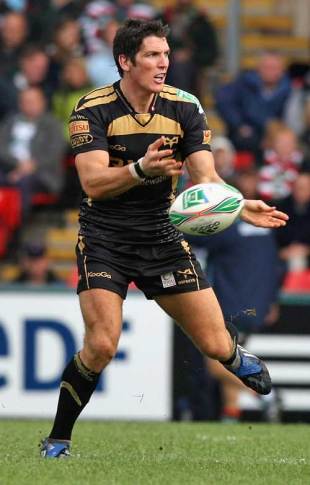|
Welsh Rugby
What does the future hold for Hook?
Huw Richards
October 13, 2009

Hook passes the ball during the Ospreys' entertaining 32-32 draw with Leicester last weekend
© Getty Images
Enlarge
Consider if you will the last few months in the working life of James Hook. First he wasn't in the Lions squad. Then, thanks to an injury to a winger, he was. Once in South Africa he played well enough to suggest that a Test place, or at least one on the bench, was in his grasp - only to miss out even on the bench, watching from the stand as Ronan O'Gara's unfamiliarity with playing centre contributed to the agonising second Test defeat. Then, the following week, he was on the bench. But when a centre went down in the closing stages it was Harry Ellis who got the call, with Mike Phillips taking his physical presence out into the midfield backs. He returns home and discovers that the Ospreys are not convinced he is their first choice at fly-half, the position in which he has played numerous Tests and is heir apparent for Wales. Little wonder it was rumoured he was feeling a touch unsettled. Who wouldn't be? There were, though, indications in the Ospreys 32-32 draw away to Leicester in the opening round of the Heineken that this latest development might just be good for both club and player. The question over Hook as an international fly-half is not whether he has the requisite talent - he has, to a degree matched by few other current performers - but over his command of the less exciting, but still more essential, art of game management. That is why he has fallen behind the more penny-plain Stephen Jones. The evidence of Sunday at Welford Road, and a fair few games over the last few months, is that the Ospreys have a player with precisely those skills. Dan Biggar, still only 19, played with remarkable control and composure amid the maelstrom at Leicester and also kicked his goals, another area in which Hook has occasionally been fallible. His combination with Hook worked well. They switched where needed and, during the periods when Ospreys had possession, Biggar made sure that Hook was constantly in the game. Hook's stated desire to play fly-half is entirely natural. Even without the mythology attached to it in Wales, it is one of the most important positions on the field, offering continuous involvement. Seven and a half years younger than Jones, he might reasonably expect to inherit before very long. But it doesn't always work out like that. Nobody ever looked a more certain heir apparent than Brynmor Williams, widely regarded as the second best scrum-half in Britain for some time before Gareth Edwards retired in 1978. Instead Brynmor was usurped by his club-mate Terry Holmes. It is not impossible the same might happen to Hook. There is also a space left, for club and country, by the absence of Gavin Henson. It has sometimes been possible to cast Hook as Henson minus the distracting hinterland and while they are not of course interchangeable - players of genuine quality never are - he looks the right man to plug that particular gap.
The competition is stiff at international level. If fit, Jamie Roberts has surely nailed down one place with his Lions performances. Tom Shanklin would challenge for inclusion in any team in the world. But if Wales are to play Phillips, Jones and Roberts - and given that all three are Lions first choices, it is hard to see why they would not - a touch of sublety and elusiveness, of the ability to create gaps by deception rather than frontal assault, will be needed to complement them. Warren Gatland also has the ingrained - and wholly sensible - New Zealand taste for the inside centre, a complementary playmaker who has the skills of a fly-half and offers additional options. To move from 10 to 12 might feel like demotion, but it ain't necessarily so. Welsh fly-halves whose footballing skills enabled fruitful international careers at centre include Dai Richards and Mark Ring. Bleddyn Williams, perhaps the greatest of Welsh centres, won his first peacetime cap at fly-half. If Biggar does prove to be the heir, his partnership with Hook could develop at club level before transferring to the international stage. It was among the positive features of a broadly encouraging first Heineken weekend for the Welsh franchises - while it was disappointing to blow an 18-point lead there is little doubt that the Ospreys would have settled beforehand for a draw, particularly when missing both first-choice props, something given considerably less air time than the Tigers losses, but no less disruptive. Where the Ospreys management may feel concern is the frequency with which they were turned over at the breakdown. Elsewhere there was a highly encouraging performance by the Dragons at Gloucester, with Joe Bearman continuing to earn rave notices in the back row, and the Scarlets best display in Europe for some time. Cardiff against Harlequins may have recalled their desperate meetings of two seasons back, but there could be no complaints about the result. No, I'm not predicting instant European domination, or anything very like it. But all four teams looked as though they belonged at this level of rugby, not something that has always been the case in the Heineken. © Scrum.com
| |||||||||||||||
Live Sports
Communication error please reload the page.
-
Football
-
Cricket
-
Rugby
-
- Days
- Hrs
- Mins
- Secs
F1 - Abu Dhabi GP
Abu Dhabi Grand Prix December 11-131. Max Verstappen ()
2. Valtteri Bottas (Mercedes)
3. Lewis Hamilton (Mercedes)
4. Alexander Albon ()
5. Lando Norris ()
6. Carlos Sainz Jr ()
-
ESPNOtherLive >>
Darts - Premier League
Golf - Houston Open
Snooker - China Open
Tennis - Miami Open

